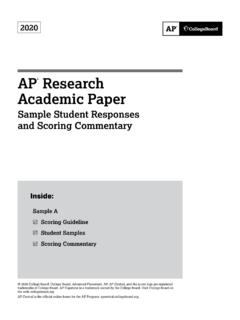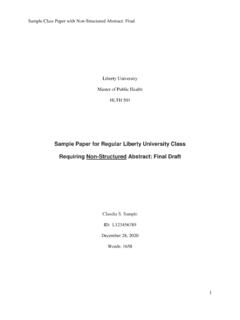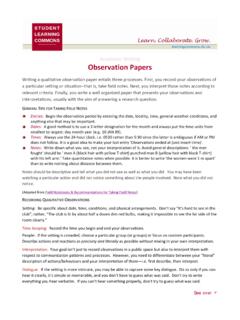Transcription of The Impact of the 2018 Trade War on U.S. Prices and Welfare
1 NBER WORKING paper SERIESTHE Impact OF THE 2018 Trade WAR ON Prices AND WELFAREMary AmitiStephen J. ReddingDavid WeinsteinWorking paper 25672 BUREAU OF ECONOMIC RESEARCH1050 Massachusetts AvenueCambridge, MA 02138 March 2019We are grateful to Gordon Hanson, Enrico Moretti and Mark Gertler for soliciting this paper for the Journal of Economic Perspectives. We thank Don Davis and Rob Feenstra for insightful comments. We thank Noah Kwicklis, Karen Ni, and Angela Wu for excellent research assistance. The views expressed in this paper are those of the authors and do not necessarily reflect the position of the Federal Reserve Bank of New York, the Federal Reserve System, the National Bureau of Economic Research, or any other institution to which the authors are affiliated.
2 Any errors or omissions are the responsibility of the authors. NBER working papers are circulated for discussion and comment purposes. They have not been peer-reviewed or been subject to the review by the NBER Board of Directors that accompanies official NBER publications. 2019 by Mary Amiti, Stephen J. Redding, and David Weinstein. All rights reserved. Short sections of text, not to exceed two paragraphs, may be quoted without explicit permission provided that full credit, including notice, is given to the Impact of the 2018 Trade War on Prices and WelfareMary Amiti, Stephen J.
3 Redding, and David WeinsteinNBER Working paper No. 25672 March 2019 JEL No. F13,F14 ABSTRACTThis paper explores the impacts of the Trump administration s Trade policy on Prices and Welfare . Over the course of 2018, the experienced substantial increases in the Prices of intermediates and final goods, dramatic changes to its supply-chain network, reductions in availability of imported varieties, and complete passthrough of the tariffs into domestic Prices of imported goods. Overall, using standard economic methods, we find that the full incidence of the tariff falls on domestic consumers, with a reduction in real income of $ billion per month by the end of 2018.
4 We also see similar patterns for foreign countries who have retaliated against the , which indicates that the Trade war also reduced real income for other AmitiMicroeconomic Studies FunctionFederal Reserve Bank of New York33 Liberty StNew York, NY 10045-0001and J. ReddingDepartment of Economicsand Woodrow Wilson SchoolPrinceton UniversityPrinceton, NJ 08544and CEPRand also WeinsteinColumbia UniversityDepartment of Economics 420 W. 118th StreetMC 3308 New York, NY 10027and Introduction Over the course of 2018, the Trump administration imposed import tariffs on approximately $283 billion of imports, with rates ranging between 10% and 50%.
5 In response, trading partners, especially China, have retaliated with tariffs averaging 16% on approximately $121 billion of exports, plunging the into its first episode of large-scale competitive tariff protection since the Great Depression of the 1930s, and raising questions about the future of international Trade integration. These kind of tit-for-tat exchanges of tariffs are typically characterized as a Trade war, a term that we adopt throughout this paper . This paper aims to explore the impacts of this change in Trade policy on Prices and Welfare .
6 While the long-run effects are still to be seen, over the course of 2018, the experienced substantial increases in the Prices of intermediates and final goods, large changes to its supply-chain network, reductions in availability of imported varieties, and complete passthrough of the tariffs into domestic Prices of imported goods. Therefore, although in principle the effect of higher tariffs on domestic Prices could be offset by foreign exporters lowering the pre-tariff Prices that they charge for these goods, we find little evidence of such an improvement in the terms of Trade up to now, which implies that the full incidence of the tariff has fallen on domestic consumers so far.
7 Our results imply that the tariff revenue the is now collecting is insufficient to compensate the losses being born by the consumers of imports. We also see similar patterns for foreign countries who have retaliated against the , which indicates that the Trade war reduces real income for the global economy as well. We argue that conventional Trade models are a powerful framework for understanding what has happened to Prices , quantities, and Welfare . The deleterious impacts of the tariffs have been largely in line with what one might have predicted based on a simple supply and demand framework.
8 We estimate the likely Impact on consumers and find that by the end of 2018, 2 import tariffs were costing consumers and the firms that import foreign goods an additional $3 billion per month in added tax costs and another $ billion dollars per month in deadweight Welfare (efficiency) losses. Tariffs have also changed the pricing behavior of producers by protecting them from foreign competition and enabling them to raise Prices and markups. If we assume that the 2018 tariffs have not affected Prices in sectors that do not use or compete with targeted imports, we estimate that the combined effect of input and output tariffs have raised the average price of manufacturing by one percentage point, which compares with an annual average rate of producer price inflation from 1990-2018 of just over two percentage points.
9 We also see evidence of large impacts of the tariffs and the foreign retaliatory tariffs on supply chains. We estimate that if the tariffs that were in place by the end of 2018 were to continue, approximately $165 billion dollars of Trade per year will continue to be redirected in order to avoid the tariffs. Given the fixed costs associated with the current supply chains, this reorganization of global value chains is likely to impose large costs on firms that have made investments in the and China, as they have to move their facilities to other locations or find alternative sources of import and export destinations.
10 2. Overview of the Trump Administration s Trade War The Trump administration s Trade war provides a natural experiment for evaluating the effects of Trade policy. Since President Trump s election was a surprise to many observers, it is unlikely that the tariffs were anticipated in the affected industries. Most observers were expecting Hillary Clinton to win, with a presumably different approach to Trade policy. A second feature of the Trump administration s Trade war that makes it useful for social scientists is that the large magnitude of the tariffs creates meaningful variation across products, time, and countries.
















